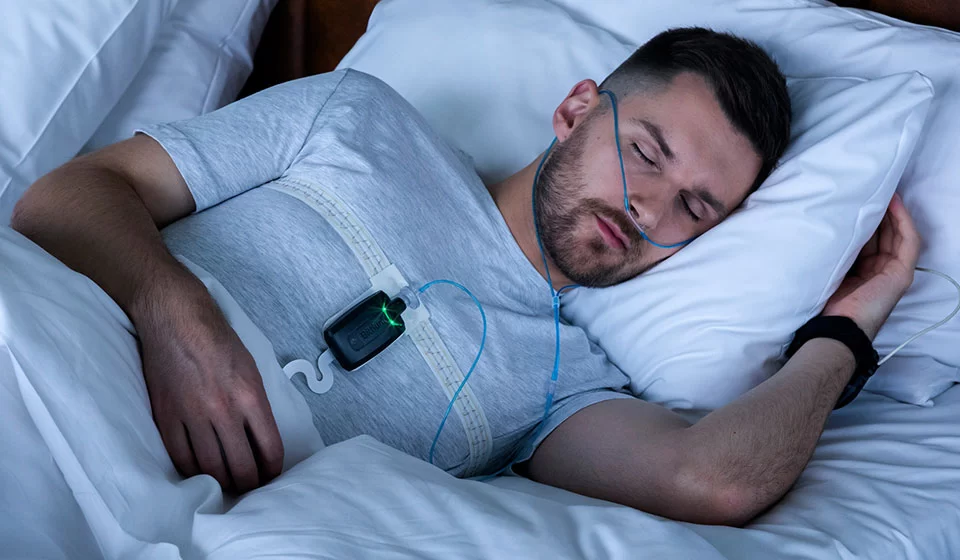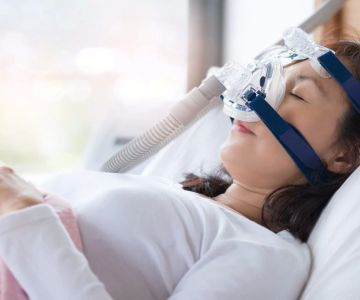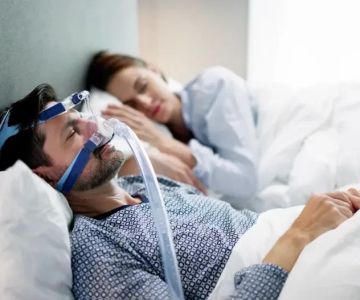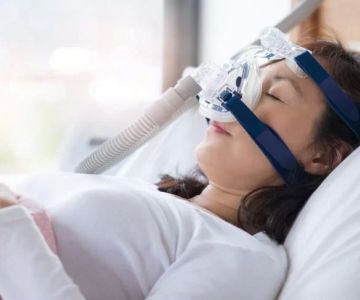
Home Sleep Apnea Test: A Convenient First Step to Better Sleep
Sleep apnea, a condition characterized by pauses in breathing during sleep, is a significant public health concern in the United States, affecting millions of Americans. According to the National Sleep Foundation, an estimated 22 million Americans suffer from sleep apnea, with many cases remaining undiagnosed and untreated. This sleep disorder not only disrupts sleep quality, leading to daytime fatigue and decreased cognitive function, but also has serious implications for overall health, including increased risk of heart disease, stroke, diabetes, and other chronic conditions. The traditional method for diagnosing sleep apnea is an overnight sleep study in a lab, a process that can be both inconvenient and expensive for many individuals. However, with advancements in medical technology, home sleep apnea tests have emerged as a convenient and accessible alternative for preliminary diagnosis. A home sleep apnea test allows individuals to monitor their breathing patterns and blood oxygen levels in the comfort of their own homes, providing valuable insights for healthcare providers. This development has made the diagnostic process more efficient and affordable, encouraging more people to take the first step towards improving their sleep. While a home sleep apnea test is not a substitute for a comprehensive evaluation, it can provide valuable data and identify individuals who are at a higher risk of having sleep apnea, therefore encouraging those who test positively to get a more detailed professional evaluation. This has resulted in more people becoming aware of their potential health risks, and taking steps toward treatment. At Dentistry Toothtruth, we recognize the importance of accessible and affordable sleep apnea testing. This article explores the benefits of home sleep apnea tests, how they work, and what to expect when using them. We also explore what next steps you should consider if your home sleep study indicates you might have sleep apnea. We hope to encourage more people to take proactive steps to improving their sleep and overall health.
Understanding the Basics of Sleep Apnea and Its Impact
To fully appreciate the role of a home sleep apnea test, it’s important to understand what sleep apnea is and how it affects the body. Sleep apnea is a sleep disorder in which breathing repeatedly stops and starts during sleep. These pauses in breathing, known as apneas, can last for several seconds or even minutes and can occur many times throughout the night. The most common form of sleep apnea is obstructive sleep apnea (OSA), which occurs when the muscles in the back of the throat relax and cause a blockage in the airway. When the airway is blocked, the brain signals the body to wake up briefly in order to restore breathing, but these awakenings are often very brief, and the individual is not often aware of them. These repeated awakenings disrupt the normal sleep cycle, leading to poor sleep quality and daytime fatigue. Additionally, during apnea episodes, blood oxygen levels can decrease, which can put a strain on the heart and other organs. The consequences of untreated sleep apnea are significant. Daytime fatigue can lead to accidents, decreased job performance, and impaired cognitive function. Moreover, chronic sleep deprivation can increase the risk of several chronic health conditions, including high blood pressure, heart attack, stroke, type 2 diabetes, and heart failure. These long-term health impacts are substantial, making early diagnosis and treatment essential. Sleep apnea symptoms can vary from person to person, but common indicators include loud snoring, restless sleep, waking up gasping or choking, daytime fatigue, difficulty concentrating, and morning headaches. Some people may also experience mood swings, irritability, or decreased libido. Not everyone who snores has sleep apnea, but snoring is often an early indicator of a potential underlying problem, and it's important to understand that not everyone who has sleep apnea is necessarily a loud snorer. Risk factors for sleep apnea include obesity, family history, being male, older age, and having certain anatomical features such as a large neck circumference or a recessed chin. If you suspect you might have sleep apnea, it's important to seek testing, so a qualified professional can recommend a course of treatment. Understanding the impact of sleep apnea is vital for encouraging individuals to take advantage of convenient testing options like home sleep apnea tests, which can help identify those who need further assessment and treatment to protect their health and improve their quality of life.
How a Home Sleep Apnea Test Works: An Overview
A home sleep apnea test (HSAT) is a portable device designed to monitor various physiological parameters related to sleep and breathing patterns. These tests are significantly more convenient and cost-effective than traditional in-lab sleep studies, making them more accessible to a wider population. A typical HSAT device includes a small monitor and sensors that are attached to the body to record data while you sleep in your own home. The most common type of device includes a nasal cannula, which is a small tube that is placed into the nostrils to measure airflow, a pulse oximeter, which is placed on a finger to measure blood oxygen levels, and a chest belt, which measures breathing patterns. The device is worn overnight and records the breathing patterns, blood oxygen levels, heart rate, and chest movement. These recorded data are then used to analyze and identify sleep apnea events. When starting your home sleep apnea test, it's crucial to follow the instructions provided with the device carefully. Usually, patients are required to attach the sensors before going to bed, ensuring they are secure and in the correct position. The device should be turned on before going to sleep and left to collect the data during the night. In the morning, the device is turned off and returned to the healthcare provider or lab, where the data is downloaded and analyzed. When analyzing the data, healthcare professionals look for patterns of pauses in breathing, decreases in blood oxygen levels, and changes in heart rate to determine whether an individual has sleep apnea and the severity of the condition. A scoring system known as the Apnea-Hypopnea Index (AHI) is often used to measure the number of apnea and hypopnea events during the sleep study. A higher AHI indicates more severe sleep apnea. It's crucial to understand that a home sleep apnea test is not a substitute for a comprehensive evaluation with a medical professional. The data provided is limited to just what it collects, and does not include information about sleep stages or brain waves. A home sleep apnea test, rather, is a tool for preliminary diagnosis and is often used as a screening tool to identify individuals who may be at a higher risk of having sleep apnea and need a more detailed assessment. However, it remains a convenient and effective way to start the journey to a better night's sleep and an improved overall well-being. After the home sleep study has been completed, a follow up with your doctor or medical professional is always essential to ensure you receive proper diagnosis and treatment.
The Key Benefits of Choosing a Home Sleep Apnea Test
Home sleep apnea tests offer several advantages that make them a compelling choice for many individuals suspecting they have sleep apnea. These benefits often outweigh the traditional methods of sleep studies, making them an appealing option for a broad audience. One of the most significant advantages is convenience. Home tests allow individuals to be assessed in the comfort of their own beds, avoiding the need to travel to a sleep lab and stay overnight in an unfamiliar setting. This factor alone reduces barriers to getting tested, especially for those who may have mobility issues or are concerned about the expense of an in-lab study. Home sleep tests also eliminate the need to disrupt daily routines. Unlike traditional sleep studies that require time off work or other daily obligations, home sleep tests can be performed on any given night, as long as the equipment is attached correctly. This can often make it easier for people to incorporate the testing into their schedules, which is a large reason why they are such an appealing choice. Another considerable benefit is the cost-effectiveness of home tests. Home sleep apnea tests are typically much more affordable than traditional in-lab sleep studies, making them accessible to more people, especially those without comprehensive insurance coverage. This affordability means that more individuals can be tested earlier, increasing the likelihood of early diagnosis and treatment. In-lab sleep studies can be expensive, often requiring many out-of-pocket expenses. Moreover, home sleep tests provide a more realistic assessment of an individual's sleep patterns, which can be more beneficial to a doctor. The test is completed in an environment that the individual is already accustomed to, leading to a more typical sleep pattern. Traditional sleep studies take place in a new setting, which can lead to altered sleep patterns that do not give a doctor a clear picture of how an individual is sleeping at home. Furthermore, home tests can reduce anxiety and stress. Some people can become anxious about the prospect of a sleep study, especially being in a new place and being monitored by professionals. Home tests can often alleviate these feelings, and make patients feel more relaxed and at ease while being monitored. The ease and accessibility of home sleep apnea tests encourage more people to seek the testing and care they need. This can lead to early intervention, which can have a huge impact on overall health and wellbeing. The home sleep apnea test represents a convenient, affordable, and stress-free way to take that first step toward better sleep and improved health.
What to Expect During a Home Sleep Apnea Test
Knowing what to expect during a home sleep apnea test can help alleviate anxiety and make the process smoother for individuals using it for the first time. First, before undergoing an at home test, the patient will meet with a doctor to discuss the details of the process and any specific needs or concerns the patient may have. It is important to always follow instructions carefully when using the home sleep apnea test, as incorrect usage may result in inaccurate results. Typically, the device will include clear instructions on how to attach the sensors, which commonly consist of a nasal cannula (airflow sensor), a pulse oximeter (finger sensor), and a chest belt. It's crucial to ensure the sensors are correctly positioned and securely attached before you go to bed. Be sure the sensors are not overly tight, and comfortable so that sleep is not negatively affected. It's also essential to make sure that all the sensors are securely attached. Loose connections may result in inaccurate results. The device should be turned on right before you go to bed, and will record data through the night. Try to maintain your regular sleep schedule. This consistency helps ensure the data collected is reliable and representative of your normal sleep patterns. You do not need to change any of your normal routines, such as the lighting of your room, your bedding, or any other aspect of your evening routine. This will ensure you are as comfortable and relaxed as possible. In the morning, when you wake up, carefully remove the sensors and turn off the device. Be sure to package up the device carefully, following all instructions to ensure that it is not damaged on its way back to the clinic or testing provider. After you return the device, the results will be analyzed. Typically, you can expect to receive the results of your test from a doctor or clinic within a few days. The results will indicate whether you are at a higher risk for sleep apnea and how severe the condition may be. Your doctor will use this information to determine the best course of action. A follow-up appointment is critical to fully understand the implications of your results and to discuss your treatment options. It is important to make sure you understand the results, and what steps you need to take next. Be sure to ask any and all questions you may have. Remember that a home sleep apnea test is designed to be simple and non-invasive, and it's generally considered to be very safe. By understanding these procedures and knowing what to expect, individuals can feel more confident and relaxed when undertaking a home sleep study.
Interpreting Home Sleep Apnea Test Results and Next Steps
Once the home sleep apnea test is completed and the data is collected, it's important to understand how the results are interpreted and what steps should be taken next. The data collected from the test is used to determine if a patient has sleep apnea, and if so, how severe the condition is. The key metric used to assess this is the Apnea-Hypopnea Index (AHI). AHI measures the number of apneas (pauses in breathing) and hypopneas (shallow breathing) that occur per hour of sleep. A higher AHI indicates a more severe form of sleep apnea. AHI results typically fall into the following categories: Normal (AHI less than 5), Mild Sleep Apnea (AHI between 5 and 15), Moderate Sleep Apnea (AHI between 15 and 30), Severe Sleep Apnea (AHI greater than 30). In addition to the AHI, home sleep apnea tests also measure blood oxygen levels. Significant drops in blood oxygen levels during sleep may indicate sleep apnea. Oxygen levels are an important metric for overall health, and should be discussed with your medical professional. It’s important to keep in mind that home sleep tests are not capable of fully diagnosing sleep apnea. They are instead used as a screening tool to indicate whether or not a person might be at risk. Therefore, a positive result on a home sleep apnea test typically requires a follow-up appointment with a healthcare provider, who can use the results and other medical history to formulate a proper diagnosis and course of treatment. A doctor will consider your individual symptoms, medical history, and the results of the home sleep test to determine the best steps forward. If the results indicate a high likelihood of sleep apnea, your doctor may recommend more comprehensive testing, such as an in-lab polysomnography, to gain more data and ensure that a proper diagnosis can be made. A medical professional will also work with you to create a personalized treatment plan based on the type and severity of your sleep apnea. These treatment plans might include lifestyle modifications, oral appliances, continuous positive airway pressure (CPAP) therapy, or other procedures. Understanding the implications of your home sleep test is a critical part of ensuring you are on the road to better sleep. Always be sure to discuss your results with a medical professional to ensure your individual needs are met and you understand the next steps you need to take.
Taking Action for Better Sleep and Overall Health
Recognizing the importance of good sleep and proactively addressing sleep apnea is crucial for overall health and well-being. A home sleep apnea test is an important step in that journey. For those who suspect they may have sleep apnea, a home test can be an invaluable first step towards diagnosis and treatment. Understanding the benefits of home testing, and knowing that they are convenient and effective, can empower you to take action and advocate for better sleep. Home sleep apnea tests are designed to be simple to use, and provide critical data that can start you on your way to a more restful sleep experience. The affordability and convenience of these methods ensure that more people than ever before can take advantage of them. If you have taken a home sleep study and the results show that you might have sleep apnea, it's essential to take prompt action and consult a healthcare professional to determine the proper steps forward. Early diagnosis and treatment can have a huge impact on your quality of life. A professional can work with you to determine which treatments are right for you, based on the severity and nature of your condition. Remember that your doctor can help you create a treatment plan that works for you, and it's important to keep in close communication with them to make sure your needs are being met. Treatment options can range from lifestyle modifications to more complex solutions such as oral appliances and CPAP therapy. Your medical professional can help you develop a personalized treatment plan that takes into consideration your specific needs and preferences, and you can work in collaboration with them to make sure the treatment is working. Taking the first step by doing a home test is the most important action you can take towards a more restful sleep experience. Don't put off taking care of your health and well being. At Dentistry Toothtruth, we are committed to providing accessible information and resources to help individuals take control of their sleep health. Explore our resources and learn more about how a home sleep apnea test can be the first step toward better sleep and improved overall well-being. We believe that a comfortable, restful night’s sleep is essential for living your best life. Don't hesitate to contact us today to begin your journey toward better sleep.







 Westgate Dental Arts
Westgate Dental Arts Coventry Family Dental
Coventry Family Dental Familia Dental
Familia Dental Dr. Daniel S. Fife, DDS
Dr. Daniel S. Fife, DDS Dentistry At Suburban Square: Michael I. Wollock, DMD
Dentistry At Suburban Square: Michael I. Wollock, DMD Comfort Care Dental
Comfort Care Dental The Importance of Oral Health Education During Pregnancy for a Healthy Pregnancy
The Importance of Oral Health Education During Pregnancy for a Healthy Pregnancy Why Skipping Dental Checkups Can Lead to Bigger Oral Health Problems
Why Skipping Dental Checkups Can Lead to Bigger Oral Health Problems Best Tips for Brushing Your Teeth Properly for Healthy Gums: Essential Techniques for Oral Health
Best Tips for Brushing Your Teeth Properly for Healthy Gums: Essential Techniques for Oral Health Advantages of Porcelain Dental Restorations
Advantages of Porcelain Dental Restorations How Can Diabetes Cause Tooth and Gum Problems? Preventing and Managing Oral Health Issues
How Can Diabetes Cause Tooth and Gum Problems? Preventing and Managing Oral Health Issues Healthy Habits for Promoting Good Oral Health and Hygiene: Tips for a Healthy Smile
Healthy Habits for Promoting Good Oral Health and Hygiene: Tips for a Healthy Smile